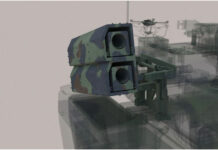The FireFly is a medium sized Precision Aerial Delivery System (PADS) platform capable of delivering 500 lb to 2,200 lb (225 kg to 1.000 kg). With a 4:1 glide ratio and 25,000 ft deployment altitude, the FireFly is capable of significant vertical and horizontal standoff. The system has demonstrated excellent accuracy, landing within 150 meters of the designated Impact Point over 80% of the time. When using the roadway landing feature, the FireFly has a greater than 80% probability of landing within 50 meters of the designated road. FireFly uses a roadway landing feature enabling the user to designate an azimuth for landing rather than the default into-the-wind heading to take advantage of roads and other paved surfaces for cargo retrieval.
The distance to the Impact Point for ram air canopies is predominantly affected by the efficient glide capability of the airfoil. Vertical deviations are multiplied by the glide ratio of the canopy. In the case of the Airborne Systems JPADS platforms, all canopies have a minimum 4:1 glide ratio meaning that if the system is 10 meters too high on approach, the system would overshoot the target by 40 meters. Left and right deviations are not affected by the glide performance of the system so the overall landing area has a rectangular shape as depicted by the graphic at right. This rectangle is known as the Roadway Landing Area.
If the system would approach the Impact Point from any direction, the Roadway Landing Area would be equivalent to the Circular Error Probable. However, by dictating the approach azimuth, the system’s potential for error is decreased significantly. If the system can be forced to fly a designated approach, the left and right limits in the Circular Error Probable do not apply and can be effectively removed from the potential landing area, a 75% reduction in the total potential landing area. The data at left are the results of test drops conducted by Airborne Systems. The results clearly show that the concept of the Roadway Landing Feature does greatly decrease the potential landing area of the system.
Operational advantages of the Roadway Landing Feature include the ability to land the system on a linear terrain feature (road, ridgeline, long axis of a Drop Zone, etc.). Landing the system on a road allows for easier recovery of the payload and reduced exposure in a potentially hostile environment.



















